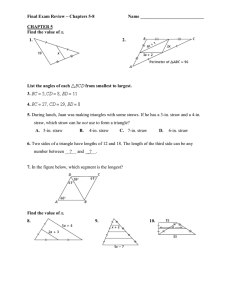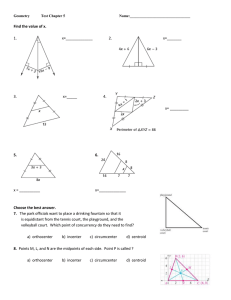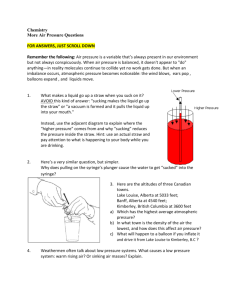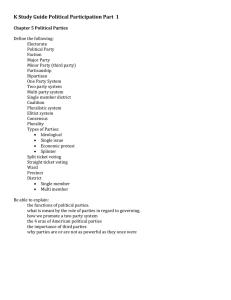Controlling Air Pollution from Straw Burning in China Calls for E *
advertisement
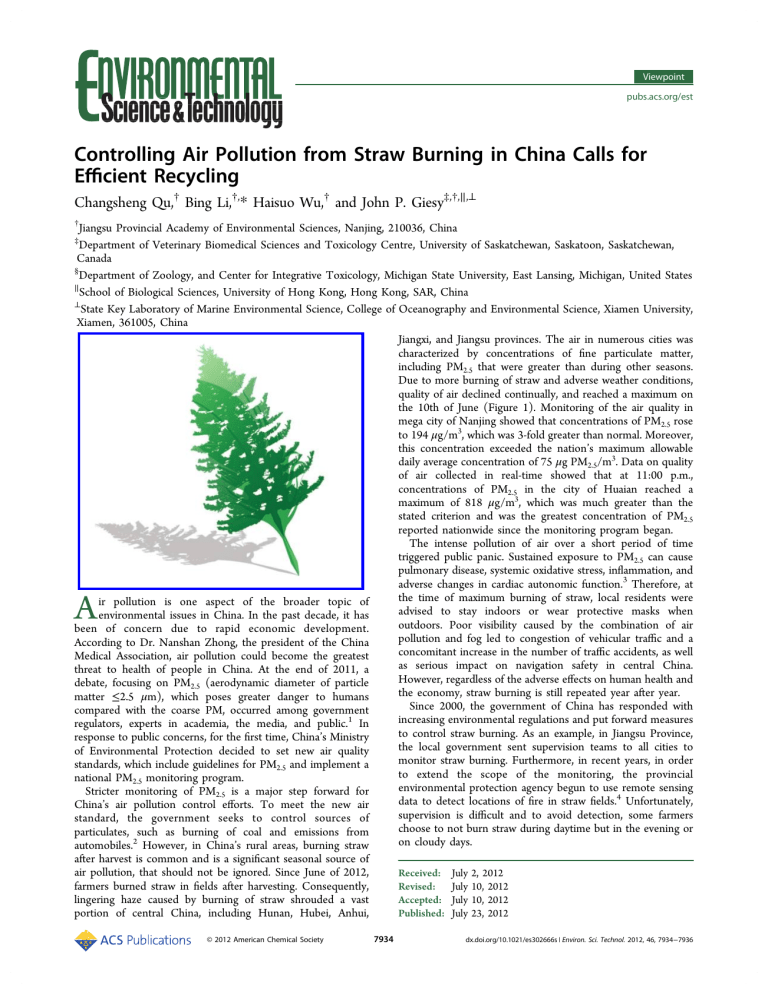
Viewpoint pubs.acs.org/est Controlling Air Pollution from Straw Burning in China Calls for Efficient Recycling Changsheng Qu,† Bing Li,†,* Haisuo Wu,† and John P. Giesy‡,†,∥,⊥ † Jiangsu Provincial Academy of Environmental Sciences, Nanjing, 210036, China Department of Veterinary Biomedical Sciences and Toxicology Centre, University of Saskatchewan, Saskatoon, Saskatchewan, Canada § Department of Zoology, and Center for Integrative Toxicology, Michigan State University, East Lansing, Michigan, United States ∥ School of Biological Sciences, University of Hong Kong, Hong Kong, SAR, China ⊥ State Key Laboratory of Marine Environmental Science, College of Oceanography and Environmental Science, Xiamen University, Xiamen, 361005, China Jiangxi, and Jiangsu provinces. The air in numerous cities was characterized by concentrations of fine particulate matter, including PM2.5 that were greater than during other seasons. Due to more burning of straw and adverse weather conditions, quality of air declined continually, and reached a maximum on the 10th of June (Figure 1). Monitoring of the air quality in mega city of Nanjing showed that concentrations of PM2.5 rose to 194 μg/m3, which was 3-fold greater than normal. Moreover, this concentration exceeded the nation’s maximum allowable daily average concentration of 75 μg PM2.5/m3. Data on quality of air collected in real-time showed that at 11:00 p.m., concentrations of PM2.5 in the city of Huaian reached a maximum of 818 μg/m3, which was much greater than the stated criterion and was the greatest concentration of PM2.5 reported nationwide since the monitoring program began. The intense pollution of air over a short period of time triggered public panic. Sustained exposure to PM2.5 can cause pulmonary disease, systemic oxidative stress, inflammation, and adverse changes in cardiac autonomic function.3 Therefore, at the time of maximum burning of straw, local residents were ir pollution is one aspect of the broader topic of advised to stay indoors or wear protective masks when environmental issues in China. In the past decade, it has outdoors. Poor visibility caused by the combination of air been of concern due to rapid economic development. pollution and fog led to congestion of vehicular traffic and a According to Dr. Nanshan Zhong, the president of the China concomitant increase in the number of traffic accidents, as well Medical Association, air pollution could become the greatest as serious impact on navigation safety in central China. threat to health of people in China. At the end of 2011, a However, regardless of the adverse effects on human health and debate, focusing on PM2.5 (aerodynamic diameter of particle the economy, straw burning is still repeated year after year. matter ≤2.5 μm), which poses greater danger to humans Since 2000, the government of China has responded with compared with the coarse PM, occurred among government increasing environmental regulations and put forward measures regulators, experts in academia, the media, and public.1 In to control straw burning. As an example, in Jiangsu Province, response to public concerns, for the first time, China’s Ministry the local government sent supervision teams to all cities to of Environmental Protection decided to set new air quality monitor straw burning. Furthermore, in recent years, in order standards, which include guidelines for PM2.5 and implement a to extend the scope of the monitoring, the provincial national PM2.5 monitoring program. environmental protection agency begun to use remote sensing Stricter monitoring of PM2.5 is a major step forward for data to detect locations of fire in straw fields.4 Unfortunately, China’s air pollution control efforts. To meet the new air supervision is difficult and to avoid detection, some farmers standard, the government seeks to control sources of choose to not burn straw during daytime but in the evening or particulates, such as burning of coal and emissions from on cloudy days. automobiles.2 However, in China’s rural areas, burning straw after harvest is common and is a significant seasonal source of air pollution, that should not be ignored. Since June of 2012, Received: July 2, 2012 farmers burned straw in fields after harvesting. Consequently, Revised: July 10, 2012 lingering haze caused by burning of straw shrouded a vast Accepted: July 10, 2012 Published: July 23, 2012 portion of central China, including Hunan, Hubei, Anhui, ‡ A © 2012 American Chemical Society 7934 dx.doi.org/10.1021/es302666s | Environ. Sci. Technol. 2012, 46, 7934−7936 Environmental Science & Technology Viewpoint Figure 1. Daily average concentrations of PM2.5 in four typical cities in main straw burning affected areas and the photos of Nanjing (left: May 21, 12 am; right: June 10, 12 am). technologies and equipment for chopping straw and ploughing it into soil should be developed and generalized. In addition, getting straw recycled into products is important as well. Local government should push for the production of domestic fungus, clad plate, and cellulosic ethanol by using straw as raw materials. Furthermore, financial incentives and subsidies are also essential. At present, the collection and recycling of the straw is often a money-losing business without government support, resulting in poor economic performance that cannot be maintained. Increasing labor costs and high transportation costs in rural areas also curb the enthusiasm of farmers for straw recycling. Accordingly, subsidies should be given to both farmers and recycling enterprises at this moment to counteract the negative environment externality caused by straw burning. Official temporary bans on straw burning have not achieved the desired results. The fundamental reason is that there is no profit in recycling straw and leaving it on farmland will affect growth of the next season’s crop. Furthermore, with the improvement of living standard, straw has been replaced as fuel in rural areas by natural gas. Thus, burning becomes the easiest way to dispose the agricultural waste. More environmentally friendly ways to deal with straw, such as fertilizing soil by burying straw deeply or making methane, requires extra money, manpower, and technology, whereas many farmers lack the technology and financial support. To address the environmental challenges posed by disposal of straw, a sustainable strategy on straw recycling should be developed in China. For different straw characteristics, developing ways of high-efficiency, low-cost and less secondary pollution can not only reduce or eliminate air pollution caused by burning, but also improve the utilization value. First, acceleration in centralized recycling of straw is needed for a sustainable future. According to preliminary statistics, the total quantity of straw in China is 600 million tons each year, of which approximately one-third is burned in open air.5 This is a great waste of resources. Although equipment to produce methane is available in some rural areas, the necessary technical and financial resources to maintain and make full use of the equipment are currently insufficient. More straw should be collected to generate electricity and methane, which would benefit both environmental protection and the energy supply. Second, more attention should be paid to return disposable straws into soil as a substitute for fertilizer. Practical ■ AUTHOR INFORMATION Corresponding Author *E-mail: lb950618@126.com. Notes The authors declare no competing financial interest. ■ ACKNOWLEDGMENTS This work was supported by Jiangsu Science Program (BM2010599), Jiangsu Blue Sky Program, and 863 Project (2007AA06A402). J.P.G. was supported by the Canada Research Chair program, an at large Chair Professorship at the Department of Biology and Chemistry and State Key Laboratory in Marine Pollution, City University of Hong Kong, 7935 dx.doi.org/10.1021/es302666s | Environ. Sci. Technol. 2012, 46, 7934−7936 Environmental Science & Technology Viewpoint The Einstein Professor Program of the Chinese Academy of Sciences and the Visiting Professor Program of King Saud University. ■ REFERENCES (1) Yuan, Y.; Liu, S.; Castro, R.; Pan, X. PM2.5 monitoring and mitigation in the cities of China. Environ. Sci. Technol. 2012, 46, 3627− 3628. (2) Zhang, Q.; He, K.; Huo, H. Policy: Cleaning China’s air. Nature 2012, 484, 161−162. (3) Pope, C. A.; Young, B.; Dockery, D. Health effects of fine particulate air pollution: Lines that connect. J. Air Waste Manage. 2006, 56, 709−742. (4) Tina, Q.; Wang, L.; Bao, Y.; Li, S. A straw extraction and strawburning fire detection mode using HJ-1B satellite measurements. Sci. Sin. Inf. 2011, 41, 117−127. (5) Cao, G.; Zhang, X.; Zheng, F.; Wang, Y. Estimation the quantity of crop residues burnt in open field in China. Resour. Sci. 2006, 28, 9− 13. 7936 dx.doi.org/10.1021/es302666s | Environ. Sci. Technol. 2012, 46, 7934−7936

